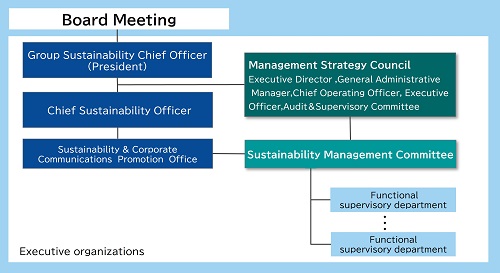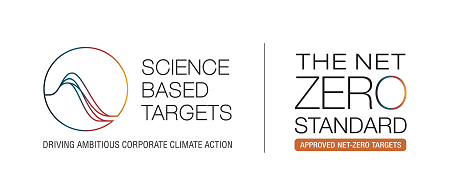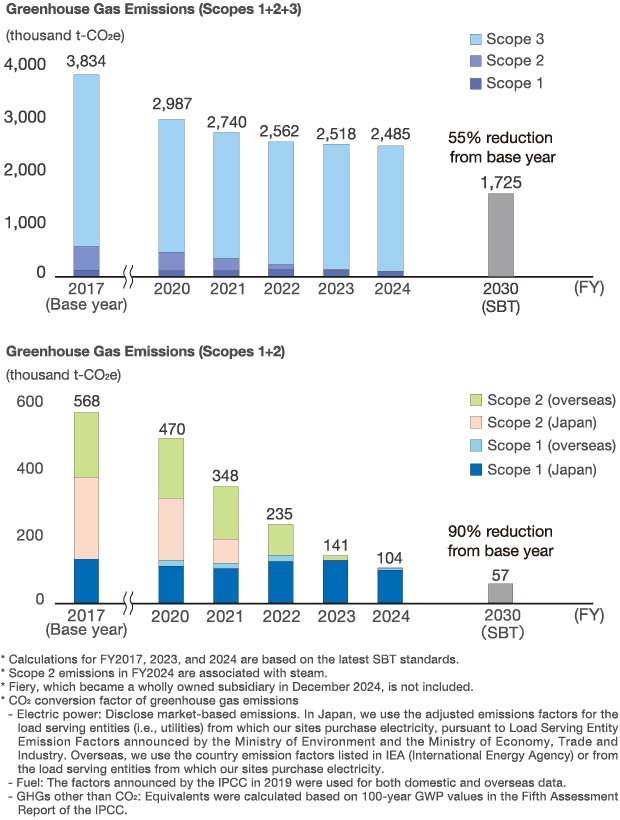Response to TCFD Recommendations
Climate change is greatly impacting society and Epson sees it as a significant societal problem. The goal of the Paris Agreement is to achieve decarbonization and limit the global average temperature to well below 2℃ above pre-industrial levels and try to limit the temperature increase to 1.5℃. To achieve this, Epson is working to reduce total emissions in line with a 1.5℃ scenario1 by 2030. Furthermore, Epson coordinated the revision of Environmental Vision 2050 with the announcement of the Epson 25 Renewed Corporate Vision. To attain our goals of becoming carbon negative and underground resource free2 by 2050, we are working to decarbonize and to close the resource loop. We are also providing products and services that reduce environmental impacts and developing environmental technologies.
Since indicating its support for the recommendations of the Task Force on Climate-related Financial Disclosures (TCFD) in October 2019, Epson has disclosed information (on governance, strategy, risk management, and metrics and targets) based on the TCFD framework so as to enable good communication with shareholders, investors, and a broad spectrum of other stakeholders. Epson has decided to disclose the level of financial impact in 2021 in a quantitative manner for the first time. Furthermore, in 2022, Epson enhanced its disclosure of specific initiatives and achievements aimed at reducing GHG emissions in response to the update to the TCFD recommendations. Since 2023, Epson has enriched qualitative and quantitative information on the highlights and specific results of its initiatives to address climate-related risks and opportunities.

1 Target for reducing greenhouse gas emissions aligned with the criteria under the Science Based Targets initiative (SBTi)
2 Non-renewable resources such as oil and metals
Scenario Analysis Results
We analyzed scenarios based on the TCFD framework to quantitatively assess the financial impact of climate-related risks and opportunities on Epson's strategy. In a 1.5℃ scenario in which there is rapid decarbonization of society, we found that there is transitional risk of an increase in operating costs due to market changes, policies, and legislation, but we expect to limit the financial impact by strengthening products and services based on inkjet technology and paper recycling technology.
Epson will spend approximately 100.0 billion yen (approximately 25.0 billion yen from 2021 to 2025 and approximately 75.0 billion yen from 2026 to 2030) over a period of 10 years ending in 2030 to accelerate decarbonization, close the resource loop, and develop environmental technology. The solution to climate-related risks aligns with the materialities we have set of achieving sustainability in a circular economy and advancing the frontiers of industry and will lead to opportunities for business expansion with Epson's low environmental impact products and services that save electricity and reduce waste. These products and services will help to mitigate customers' environmental impact and control climate change.
Based on the results of these analyses, Epson will continue to try to maximize its opportunities while addressing recognized risks in order to achieve decarbonization, which we believe is a rational goal both for society and for Epson.
On the other hand, even in a 4℃ scenario in which global warming has advanced because the world failed to take additional measures, we found that the impact of physical risks on our domestic and overseas sites due to the damages arising from weather extremes would be small.
Governance
Important matters related to climate change are reported to and deliberated by the Management Strategy Council, an advisory body to the president. They are subsequently reported to the board of directors at least once a year so that the board can exercise appropriate supervision.
The President and Representative Director has the highest responsibility and authority for climate-related issues. Chief Sustainability Officer has been appointed a Sustainability & Corporate Communications Promotion Officer to manage and promote these initiatives as the head of sustainability activities, including the TCFD. The Global Environmental Strategy Promotion Office and various subcommittees are responsible for formulating and carrying out company-wide environmental strategies, including actions to respond to climate change.
To build a more effective sustainability governance framework and to clarity responsibility, we have linked exective compensation in the form of restricted stock to a performance indicator related to decarbonizationーone of the key sustainability topics tied to materiality.

Main Climate Change Initiatives
| FY2019 | FY2020 | FY2021 | FY2022 | FY2023 | FY2024 |
|---|---|---|---|---|---|
|
|
|
|
|
|
Strategy
Epson has determined that achieving sustainability in a circular economy. To achieve these, we are reducing greenhouse gas (GHG) emissions by leveraging our efficient, compact, and precision technologies to drive innovation.
Roadmap to achievement of the Environmental Vision 2050
Epson has established the Environmental Vision 2050, under which efforts are being made to achieve not only carbon neutrality by 2050, but also carbon negativity, while aiming for products that are free from underground resources. The “Mid-Range Environmental Action Plan” outlines specific scenarios of how progress will be made towards this goal. With expansion of businesses in the growth areas and new areas that “Epson 25 Renewed” aims at, GHG emissions and resource consumption throughout the supply chain are expected to increase. To address this, an “Environmental Value Creation Scenario” has been formulated that integrates both environmental and business strategies across all operations, laying out a roadmap to achieve the 2050 targets.
Furthermore, to increase resilience against climate change, we have been implementing activities at regular meetings of the Environmental Strategy Council and its subcommittees to realize our Environmental Vision 2050. In FY2024, we reviewed the status of implementation of activities and submitted deliberations and reports to various corporate management bodies, focusing on the following initiatives.
Initiatives for FY2024
- Considering topics: decarbonization targets (renewal of SBTs), TNFD disclosures, and definition of and measures for resource circulation
- Reviewing efforts of each subcommittee and medium-term KPIs
- Sharing the progress and challenges of the Environmental Value Creation Scenario for each operation
- Investigation and analysis of the current situation (trends of competitors and society, environmental laws and regulations, etc.)
Scenario Analysis of Climate-Related Risks and Opportunities
Epson identified and evaluated scenarios in the categories of transition risk, physical risk, and opportunity to evaluate the importance of climate-related risks and opportunities. Seven risks and opportunities were singled out for evaluation. We evaluated the business impact and financial impact of each on the basis of the scenarios corresponding to temperature increase of 1.5℃ presented by the Intergovernmental Panel on Climate Change (IPCC) and the International Energy Agency (IEA) as well as on the basis of internal and external information.

Climate-Related Risks and Opportunities in a 1.5℃ Scenario
The results of evaluating climate-related risks and opportunities based on scenario analysis are as follows.
| Category | Items | Actualization1 | Business impacts | Financial impact2 | |
|---|---|---|---|---|---|
| Transition risks | Market changes Policy & laws and regulations | ・Paper demand | Short-term | Impact
|
Small |
(Initiatives in "Environment Vision 2050")
|
Short-term | Impact
|
Invest a total of approximately ¥100.0 billion by 2030 |
||
| Physical risks | Acute | ・Damage to business sites due to floods | Long-Term (End of 21st century) |
Impact
|
Small |
| Chronic | ・Damage to business sites due to rising sea levels | ||||
| ・Impact on operations due to drought | |||||
| Opportunities | Products and services | (Initiatives in "Environment Vision 2050")
|
Short-term | Assumed scenarios
|
Large by FY2025 |
| ・Environmental business | Short-term | Assumed scenarios
|
Medium |
||
1 Short term: < 10 years Medium term: 10-50 years Long term: > 50 years
2 Small: < 1 billion yen Medium: 1-10 billion yen Large: > 10 billion yen
FY2024 Actions
Epson implemented the following initiatives in FY2024 to promote decarbonization, close the resource loop, develop environmental technology, and mitigate environmental impacts on the customer's end.:
| Category | Items | Initiatives implemented in FY2024 | FY2024 quantitative results | |
|---|---|---|---|---|
| Transition risks | Market changes Policy & laws and regulations | ・Paper demand |
|
Small3 |
| ・ Decarbonization |
|
¥7.58 billion
Cumulative input costs and
|
||
| ・Closed resource loop |
|
|||
| ・Environmental technology development |
|
|||
| Physical risks | Acute | ・Damage to business sites due to floods |
|
Small3 |
| Chronic | ・Damage to business sites due to rising sea levels | |||
| ・Impact on operations due to drought | ||||
| Opportunities | Products and services | ・ Customer environmental impact mitigation |
|
FY2020 → FY2024 Revenue CAGR +9.9%7 |
| ・Environmental business |
|
- | ||
3 Small financial impact: less than ¥1 billion.
4 Excluding some rental properties housing sales sites.
5 Assessed using IPCC climate change scenarios RCP 2.6 (2℃), RCP 8.5 (4℃).
6 A major domestic site with a long-term flooding risk (end of 21st century).
7 Comparison of actual results for FY2022 to FY2023 forecasts at the time of announcement of Epson 25 Renewed.
8 PoC (Proof of Concept): A process to verify the feasibility and actual effect of a new technology, etc.
Initiatives for carbon pricing
Epson prepared payback period criteria and guidelines that incorporate carbon pricing principles to evaluate (study the feasibility of) potential investments before executing for reducing GHG emissions. They were introduced on a trial basis in FY2018 and were formally adopted in 2020.
Risk Management
As the environment in which we operate grows more complex and uncertain, effectively dealing with risks that could have a significant impact on corporate activities will be essential in order to carry out business strategies and business objectives.
Epson sees climate-related issues as risks that could significantly impact management and manages them appropriately.
Climate-Related Risk Identification, Assessment and Management Process
| 1. Study | 2. Identify & assess | 3. Manage |
|---|---|---|
|
|
|
Indicators and Targets
Epson aims to achieve the medium- and long-term greenhouse gas (GHG) emission reduction targets to realize Environmental Vision 2050. For this reason, we are working to reduce environmental impacts throughout the value chain by improving the environmental performance of our products, utilizing renewable energy, enhancing our business activities and taking other steps based on our efficient, compact, and precision technologies.
After our 2018 Science Based Targets (SBTs)1were set, we raised our goals in line with the 1.5-degree target and made efforts towards achieving them for FY2025. As a result, we replaced all electricity used at all our global sites with renewable energy ahead of the target year. Furthermore, in May 2025, the Science Based Targets initiative (SBTi)2 approved our netzero target, which is based on the SBTi Net-Zero Standard, as well as our near- and long-term targets for the process up to achieving our net-zero target. This confirms that our targets for total emissions that include all scopes and aim to be achieved by 2030, which were already set in our Environmental Vision 2050, are scientifically sound to achieve the 1.5°C target in the Paris Agreement.

GHG Emission Reduction Targets and Vision
| Targets approved for SBTi12 (1.5°C target level. All reductions are compared to the baseline year of fiscal 2017) |
Near-term targets: Reduce total scope 1+2+3 emissions by 55% by 2030 Reduce total scope 1+2 emissions by 90% by 2030 Long-term targets: Reduce total scope 1+2+3 emissions by 90% by 2050 Achieve net-zero by 2050 |
| Goals3 | Achieve net-zero Scope 1+2 emissions by 2030 Achieve carbon negative by 2050 |
Scope 1: Direct emissions from the use of fuels by business parties
Scope 2: Indirect emissions from energy sources such as electricity
Scope 3: Indirect emissions from the company's entire value chain
1 Science-based greenhouse gas reduction targets
2 The Science Based Targets Initiative (SBTi) is a corporate climate action organization that helps companies and financial institutions contribute to addressing the climate crisis. The Initiative is developing standards, tools, and guidance to help companies set GHG emission reduction targets consistent with the levels needed to keep global warming below catastrophic levels and achieve net zero by 2050 at the latest.
3 A target approved by SBTi to reduce total emissions by 90% and neutralize remaining emissions through absorption, credits, etc. to achieve net-zero emissions or further decarbonization.




